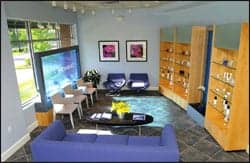 |
| Waiting area of the Blue Water Spa Laser Hair Removal Center and Medical Spa, Raleigh, NC. |
Perhaps your practice has grown, or maybe you are tired of vying for exam- and procedure-room time with office partners. You may just want to offer more spa-type services. There are many reasons for practices to move into different environs.
After unpacking the final boxes, most physicians say that moving to a new location allowed their practices to thrive. However, they also say that an office transplant is no simple operation and that it will take more time, effort, and money than one expects.
Time for a Change
In many ways, making a decision to move offices is similar to deciding to move out of a parent’s house. But instead of Mom or Dad and the siblings cramping your style, it is the partner or co-tenant who is dominating the exam rooms or waiting outside the door and watching the clock. Plus, it can be difficult to take advantage of one’s growing reputation if shared office space and time are finite commodities.
When Jeffrey Thaxton, MD, and his wife, Rebecca McGraw-Thaxton, MD, established their first practice in Vail, Colo, they were limited to having 15 minutes with each patient.
“It wasn’t so much that I needed more space,” Thaxton says. “I needed more time to see patients. When I was sharing space with another physician, our stuff was getting in each other’s way, and it was hard to find time to see everybody I needed to see. Then, the other physician was having to see people, too, so we were overlapping each other’s time.”
For plastic surgeon Linda Li, MD, FACS—owner of Aesthetic Perfection Plastic and Reconstructive Surgery in Beverly Hills, Calif—and her practice manager, Libby Everhart, not having enough time for the increasing number of consults and postoperative visits was one factor. Having space to accommodate additional staff was another. Third, Li believed that she had enough patients to merit building her own surgical room.
“When we took a look at how fast my practice was growing, we realized that we would do much better in terms of revenue and time management by having our own operating room,” Li says.
Sometimes, relocations even cross state lines. Michael Law, MD, and his wife and business partner, Kile Law, decided to relocate not just across town, but from Beverly Hills to Michael Law’s hometown of Raleigh, NC. There, the Laws built a medical practice integrated with a medical spa that they named The Blue Water Spa Laser Hair Removal Center and Medical Spa. The move and the new building gave the Laws the opportunity for independence and creativity.
“Our first place was a concrete slab when we first moved in,” Kile Law remembers. “It was difficult, but nice that we were able to really have what we wanted, the way that we wanted it.”
Their initial 3,000-square-foot venture became so successful that the couple eventually took over an adjacent 2,500-square-foot space to establish a separate laser hair-removal center.
“More than anything, our laser business was growing so much that we wanted to add new lasers, and we wanted to be sure that each laser had a dedicated room,” Kile Law says. While initially costly, the strategy of one room per laser allowed an easy workflow for the practice’s rapidly increasing volume for laser spa procedures, such as hair removal, skin tightening, and treatment for benign vascular lesions.
Practice Reconstruction
After finding a location, the more challenging aspects of the move begin: design and construction.
For the Thaxtons, there was no need to hire a professional interior designer or decorator. Because real estate is such a premium in the Vail area, they had already researched ways to make the most out of whatever space they found. As a result, when they did find their future location, the Thaxtons placed their exam rooms in a pod configuration. This design not only saved space, but also saved time by cutting down the number of steps between patients. Thaxton then placed his office far enough away from the exam rooms that he would not be tempted to walk in and get distracted with e-mails or messages between patients.
After considering what he wanted out of the space, Thaxton drew rough plans on a sheet of paper and gave it to a professional architect to implement for blueprints. The Thaxtons also picked out their own furniture, wallpaper, and carpets.
“It was almost like a girl’s dream to get to go into a store and say, ‘I want that, that, and that,’ ” McGraw-Thaxton says. “We went into this local furniture store together, and we thought really hard about what we wanted: just a warm personality for the office and waiting room.” Furniture shopping didn’t take long, as the couple found what they wanted after visiting only two stores.
 |
| Linda Li (foreground) stands amid the construction of her practice, which was remodeled to accommodate more patients and staff. |
Law also did his own initial design for their original Raleigh build-out, and his wife—a former medical-products clinical trainer and spa consultant from Newport Beach, Calif—had no problem executing the medical spa atmosphere they wanted. When it came time to expand into the adjacent space for their laser center, the Laws kept the walls of the previous tenants and simply redecorated to make it consistent with the main practice.
Li decided to consult with several architectural firms that had been recommended by her commercial real estate broker. She gave them the task of creating a design that would give the space a modern and relaxed feeling.
“We had a certain idea of how we wanted the flow of the office to be and how to best make use of the natural lighting that we have here,” she says. “And we had to be clear that it had to be very aesthetically pleasing to the eye, because it’s an aesthetic business.”
It took three design passes for the 1,800-square-foot space before Li found an architect who was on her same page. The final plan incorporated two exam rooms, two offices, a front and back office for staff to work in, and an operating room. It also made use of the 14-foot, east-facing windows, allowing light to flow through the front of the office. With Li’s vision set on blueprints, the next step was building it.
Contractors, Overruns, and Delays
Whether building your dream home or your dream office, dealing with contractors can be painful.
Although Thaxton drew the rough design of what he wanted, the contractor’s architect had difficulty executing those plans from a builder’s standpoint. In addition, work did not start when promised.
When Thaxton intermittently checked on the progress, he learned about delays because a subcontractor did not show up or because another was behind on finishing a section. This meant that construction could not move forward until the underlying work was completed, and their initial cost and time estimates soon went out the window.
“The best advice I can give for someone who is using an architect and a contractor is to visit the space daily,” Kile Law says. “We came by one day as they were building and found that in our main entryway, two people couldn’t walk by without turning their shoulders.”
 |
| Li’s practice after completion of reconstruction. |
Because of their visit, the Laws were able to correct the error before the walls were built, averting a costly mistake. However, even while staying on top of their contractor, the Laws still could not prevent the project from going over budget and opening later than anticipated.
Although Li says that she was extremely happy with her contractor and the work that he ultimately did, she knew even before construction started that the project would be late and over budget.
“When [the contractor] gave us our time line, I thought, ‘There’s no way it’s going to be ready by when they told us it’s going to be ready,’ ” she says. “And I was right—it was about 6 months longer.”
Those delays were expensive. Li had to pay for storage for the new furniture they had bought, not to mention the 6 months of double rent. However, she did not hold the contractor accountable for those extra expenses.
“Ultimately, you just eat it,” she says. “You realize it’s just part of your build-out—it’s going to cost more than you think it will, and it’s going to take you longer than you think it will. As long as you’re willing to accept that, it goes very smoothly.”
Because the Laws’s new laser center was going to be built next door to their existing practice, they also prepared their office staff and patients for any additional noise. “There were times that we thought there would be more noise than usual, so we were just careful about not scheduling surgical complications, Botox treatments, or spa services,” Kile Law says. “We felt like people coming in for laser treatments generally were OK with a little bit of extra noise, but we just let them know about it ahead of time.”
Warning patients about the possible noise also allowed the Laws to share their plans for a new laser center. “It was a great way to get patients involved from the get-go,” Kile Law says. “It helped them to anticipate the possibility of some inconveniences, making sure that they would be a little bit more forgiving than they might otherwise be, and it also made patients feel like they were in on it with us.”
Finally: Moving In
When the contractors are finished—or mostly finished—physicians, staff, and patients may be anxious to get into the new space. While physicians welcome the excitement, especially from patients, many also believe it is prudent to transition as slowly as possible. Still, it can be hard to keep the excitement at bay.
McGraw-Thaxton says that many of their clients came by to see the new office, though she tried to tell them to wait. “There was a lot of apologizing and a lot of stepping over things,” she says. “We had no cabinets or countertops at one point.”
But the patients did not mind; they were excited for the Thaxtons. In the end, the Thaxtons managed to keep their same patient volume, despite the transition glitches.
Li happened to be on maternity leave during the transition, but says that she would have dropped the practice to a bare minimum in any case. “I really believe that giving your office staff a chance to settle in is important ultimately to the future of your practice,” she says.
“[This includes] knowing where you’re going to put particular files, and organizing yourself so you can easily access things. When you’re used to having one thing in a specific place and then you move, you reorganize things. You need a chance to put it where you feel most comfortable.”
The downtime also gave Li and her staff the opportunity to deal with glitches, such as fixing the new telephone equipment, which was installed improperly.
The Laws also had some malfunctions, such as the air conditioning not working properly. For those clients who were inconvenienced by the warmer-than-normal temperatures, the Laws offered to make it up to them by inviting them in for another treatment, for example. “Being proactive and doing something about [any problem], that has really helped to strengthen the relationship that our patients have with us,” Kile Law says.
The Laws also made sure that all of their new laser equipment was thoroughly researched before purchases and that their staff was trained and educated about the new devices before the opening. Kile Law says, “We made a big investment in the technology and in the space, so we wanted to make sure our staff was prepared to perform the treatment safely and effectively, and we also wanted to be certain we could answer questions that people had about the treatments we had available.”
Getting the Word Out
Having staff members remind patients about the move is another important transition task. Despite implementing this precaution, patients will often forget and arrive at the old address, so staff should expect an increase in late appointments for the first 5 or 6 months after moving.
Some physicians have a small party or grand opening to introduce patients to the new facility—but aside from word of mouth, a letter or e-mail announcement is quite effective for informing patients and promoting the new office.
The Thaxtons say that they received a huge response from their letter campaign, which informed their patients about the ongoing status of the move.
The Laws also invested in print advertising, publicizing that they had done a great deal of research on laser equipment and explaining why they chose the equipment that they did. “It was more than, ‘We’re open,’ ” Kile Law says.
In Li’s case, she needed no more publicity about the move than she already had. Since her practice is regularly featured on a nationally aired television program called Dr. 90210, viewers and potential clients were well aware of her move. She said that agreeing to do the show was the best marketing decision she ever made.
Well Worth It
Despite all of the frustrations, expense, and delays associated with relocation, all three practices report that their businesses have increased dramatically since the move and that their clients are more satisfied as well.
“Business just took off a great deal more once I got the space,” Thaxton says. “People felt it was moving forward. I suddenly had a lot more patients when it was my own office.”
Thaxton adds that, although he would like to have his own operating room in a few years, for now, he is comfortable and has no plans to expand the practice. That said, there just happens to be space available in the office next door.
Tor Valenza is a staff writer for Plastic Surgery Products. For more information, please contact [email protected].





